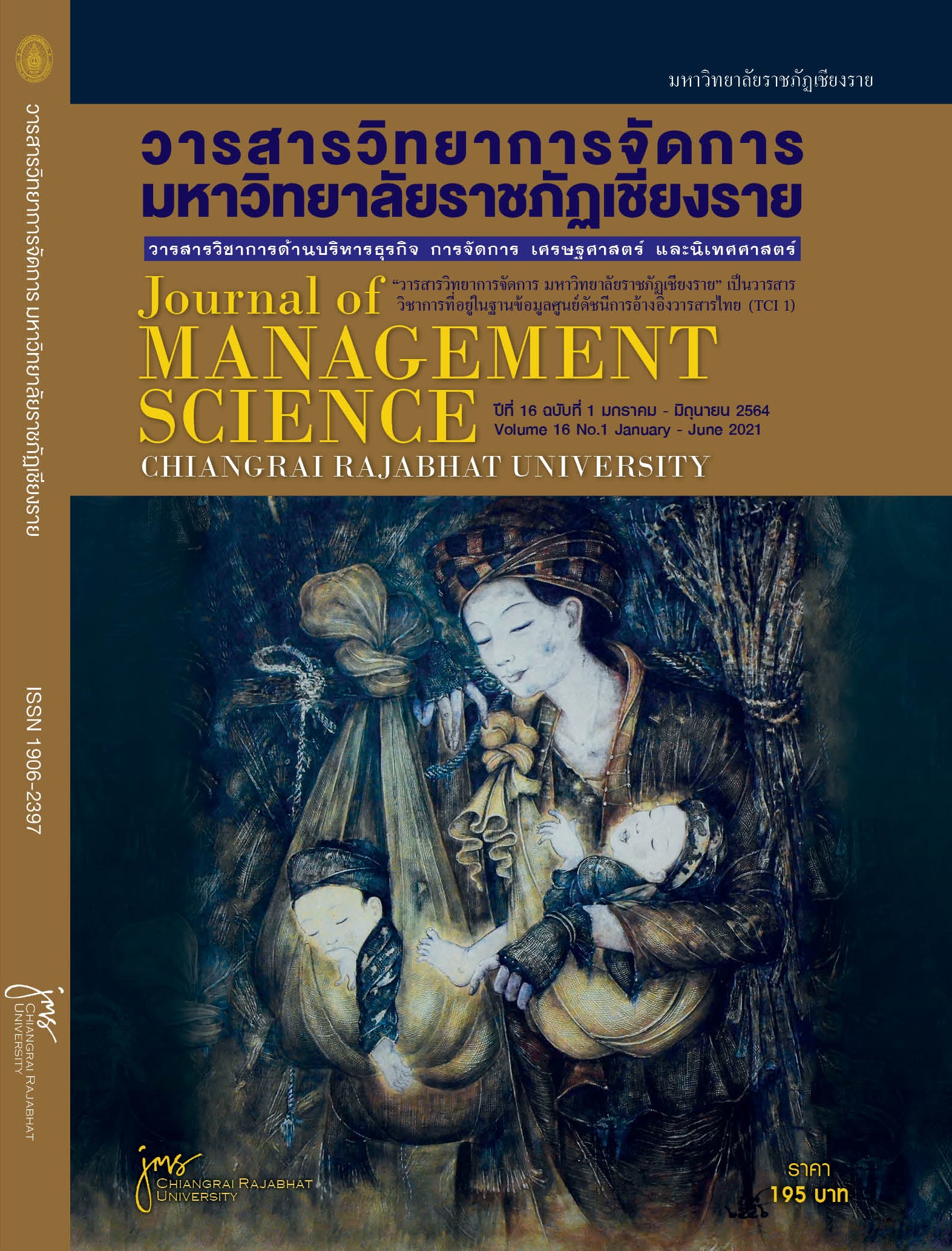Market Opportunities and Accessibility for Consumers of Thai Tea: Trends, Trade, Consumer Behaviors, and Marketing Strategy in ASEAN
Main Article Content
Abstract
The research entitled ‘Market Opportunities and Accessibility for Consumers of Thai Tea: Trends, Trade, Consumer Behavior, and Marketing Strategy in ASEAN’ aims to study business opportunities and trade barriers for Thai tea products (dried tea leaf and tea products) in the ASEAN market. Moreover, this research also specifically aims to study ASEAN consumer behavior regarding tea and tea products. This research adopted a qualitative approach as this allows researchers to acquire in-depth information from key informants. A literature review was conducted to collect general information and extant knowledge about tea, tea production, and the trade situation in the cultivated tea area in Thailand. Researchers used data from databases from the Office of Agricultural Economics, Thai Customs, and Global Trade Atlas, along with field surveys and in-depth interviews to analyze trends in tea trading. The results revealed that Myanmar, Laos, Cambodia, Indonesia, the USA, the Netherlands, China, and Vietnam were the main export markets for Thai tea and tea products. Overall, the import value of black tea leaf and green tea leaf imported by Thailand was worth in value rather than to export. However, Thailand received a positive trade balance for tea products (other than tea leaves). This study revealed that there was a limitation of cultivated tea area as tea could only be grown in the northern part of Thailand, reflecting the low quantity of tea leaf. On the other hand, Thailand has value-added potential by processing just dried tea leaf into new products such as various types of beverages. Concerning consumer behavior, ASEAN consumers consume black tea more than green tea, yet consumer demand for green tea has increased significantly recently. Consumers drink tea on average approximately three times per week. The consumers were divided into two groups, general consumers and health-concerned consumers. The young age group tends to be satisfied with ready-to-drink tea. When considering purchasing factors, the young-age group places importance on colorful packaging and television commercials, while the working-age group and the older-age group give precedence to the sugar quantity in tea products.
Article Details

This work is licensed under a Creative Commons Attribution-NonCommercial-NoDerivatives 4.0 International License.
Views and opinions expressed in the journal do not necessarily reflect those of the editors.
References
Abeygoonaratne, M. V. C., & Kularatne, M. G. (2015). Factors influencing tea consumption behavior in Sri Lanka (with special reference to Ratmalana divisional secretariat in Colombo district).
Etzel, M. J., Walker, B. J., & Stanton, W. J. (2001). Marketing (12thed.). New York: McGraw- Hill Irwin.
Food and Agricultural Organization. (2018). World tea production and consumption. Retrieved from http://www.fao.org/faostat/en/#data/QC
Global Trade Atlas. (2018a). Thailand Export Statistics Commodity: 0902, Tea, Whether Or Not Flavored. Retrieved from http://gtis.com/gta/secure/htscty_wta.cfm?commodity=0902&comparison=YEARLY&impexp=E&stat=V&year_=2017&month_=12&country=Thailand&orderby=V6%20 DESC
Global Trade Atlas. (2018b). Thailand Import Statistics Commodity: 0902, Tea, Whether Or Not Flavored. Retrieved from http://gtis.com/gta/secure/htscty_wta.cfm
Global Trade Atlas. (2018c). Reporting Countries Export Statistics (Partner Country: World) Commodity: 0902, Tea, Whether Or Not Flavored. Retrieved from http://gtis.com/gta/secure/htscty_gta.cfm
Global Trade Atlas. (2018d). Reporting Countries Import Statistics (Partner Country: World) Commodity: 0902, Tea, Whether Or Not Flavored. Retrieved from http://gtis.com/gta/secure/htscty_gta.cfm
Jayaranjani, S. R., & Dharmadasa, R. A. P. I. S. (2012, February). A Study of Tea Export Marketing in Sri Lanka: Application of Boston Consulting Group Matrix. In Proceedings of International Conference on Business Management (Vol. 8).
Kaplinsky, R. and M. Morris. (2001). A handbook for value chain research. Working Paper Prepared for the IDRC, Brighton, UK, Institute for Development Studies.
Kotler, P. (2000). Marketing management: The millennium edition. Marketing Management, 23(6), 188-193.
Nasim, S., Saleem, F., & Ali, S. G. (2015). Analysis of BTL Activities on Customer Satisfaction of Tea. Asian Journal of Research in Marketing, 4(2), 26-34.
Octavia Tea. (2016). The Octavia Tea Guide: Natural Remedies for Stress and Depression. Retrieved from http://www.octaviatea.com/blog/?p=907
Porter, M. (1985). Competitive Advantage. The Free Press. New York. 11-15.
Rieple, A., & Singh, R. (2010). A value chain analysis of the organic cotton industry: The case of UK retailers and Indian suppliers. Ecological Economics, 69(11), 2292-2302.
Sakthirama, V., & Venkatram, R. (2013). An analysis on Food Choice Motives of Organic Tea in Coimbatore. Journal of Contemporary Research in Management, 8(2), 35.
Schiffman, L. G., & Kanuk, L. L. (1994). Consumer Behavior (5th Ed.). NY: McGraw-Hill. Siddiqi, Z.,
Stabell, C. B., & Fjeldstad, Ø. D. (1998). Configuring value for competitive advantage: on chains, shops, and networks. Strategic Management Journal, 413-437.
Sumpanvejsopa S., Winyayong P., Teppakorn T., Aungvanichchayaphan P. (2008). A study on the Current Status of Tea in Thailand. Research project full report. Bangkok
Teppakorn Teerapong. (2014). Tea: manufacturing process and chemical component from fermentation. Burapha Science Journal, 17(2),
-196.
Thai Customs. (2021). Thailand Export Statistics Report: 0902, Tea, Whether Or Not Flavored. Retrieved from http://www.customs.go.th/statistic_report.php?show_search=1&s=ug797Tb5wrGK3gEF
Thai Trade. (2021). Annual Thai Exports: 0902, Tea, Whether Or Not Flavored. Retrieved from http://tradereport.moc.go.th/Report/Default.aspx?Report=HarmonizeYearly&Lang=Th&ImExType=2&Option=6
Trade Map. (2016). List of exporters for the selected product Product: 0902 Tea, whether or not flavored. Retrieved from https://www.trademap.org/Country_SelProduct_TS.aspx?nvpm=1|||||0902|||4|1|1|2|2|1|2|1|
Workman, D. (2021). Tea Exports by Country. Retrieved from https://www.worldstopexports.com/tea-exports-by-country/
Yohannes, M. F., & Matsuda, T. (2015). Demand Analysis of Non-Alcoholic Beverages in Japan. Journal of Agricultural Science, 7(5), 143.
Yue, N., Kuang, H., Sun, L., Wu, L., & Xu, C. (2010). An empirical analysis of the impact of eu’s new food safety standards on china’s tea export. International journal of food science & technology, 45(4), 745-750.


